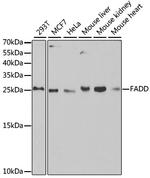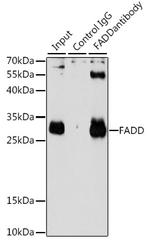Search Thermo Fisher Scientific
FIGURE: 1 / 2
FADD Antibody (PA5-117027) in WB


Product Details
PA5-117027
Species Reactivity
Host/Isotype
Class
Type
Immunogen
Conjugate
Form
Concentration
Purification
Storage buffer
Contains
Storage conditions
Shipping conditions
RRID
Product Specific Information
Positive Samples: 293T, MCF7, HeLa, Mouse liver, Mouse kidney, Mouse heart
Immunogen sequence: MDPFLVLLHS VSSSLSSSEL TELKFLCLGR VGKRKLERVQ SGLDLFSMLL EQNDLEPGHT ELLRELLASL RRHDLLRRVD DFEAGAAAGA APGEEDLCAA FNVICDNVGK DWRRLARQLK VSDTKIDSIE DRYPRNLTER VRESLRIWKN TEKENATVAH LVGALRSCQM NLVADLVQEV QQARDLQNRS GAMSPMSWNS DASTSEAS
Target Information
The protein encoded by this gene is an adaptor molecule that interacts with various cell surface receptors and mediates cell apoptotic signals. Through its C-terminal death domain, this protein can be recruited by TNFRSF6/Fas-receptor, tumor necrosis factor receptor, TNFRSF25, and TNFSF10/TRAIL-receptor, and thus it participates in the death signaling initiated by these receptors. Interaction of this protein with the receptors unmasks the N-terminal effector domain of this protein, which allows it to recruit caspase-8, and thereby activate the cysteine protease cascade. Knockout studies in mice also suggest the importance of this protein in early T cell development.
For Research Use Only. Not for use in diagnostic procedures. Not for resale without express authorization.
References (0)
Bioinformatics
Protein Aliases: Fas (TNFRSF6)-associated via death domain; FAS-associated death domain protein; FAS-associating death domain-containing protein; Fas-associating protein with death domain; Growth-inhibiting gene 3 protein; Mediator of receptor induced toxicity; mediator of receptor-induced toxicity; MGC8528; protein FADD
Gene Aliases: FADD; GIG3; MORT1; Mort1/FADD
UniProt ID: (Human) Q13158, (Mouse) Q61160
Entrez Gene ID: (Human) 8772, (Mouse) 14082, (Rat) 266610

Performance Guarantee
If an Invitrogen™ antibody doesn't perform as described on our website or datasheet,we'll replace the product at no cost to you, or provide you with a credit for a future purchase.*
Learn more
We're here to help
Get expert recommendations for common problems or connect directly with an on staff expert for technical assistance related to applications, equipment and general product use.
Contact tech support
